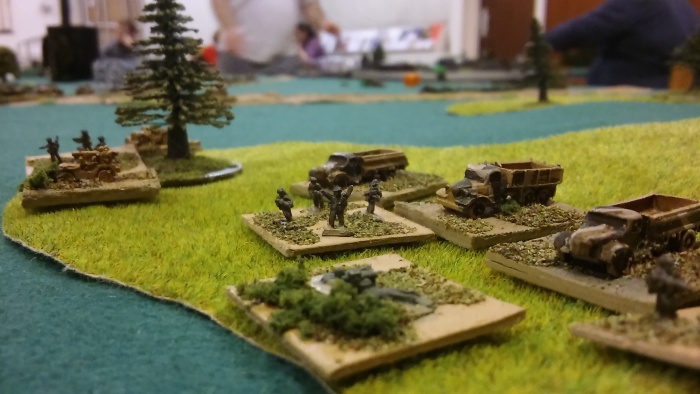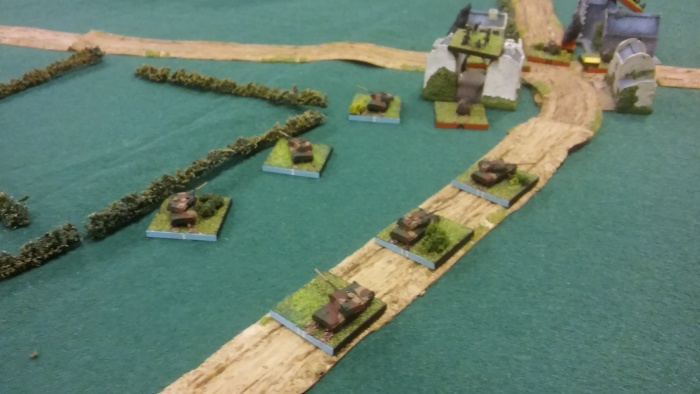Part 4 of a series exploring a hypothetical Byzantine state in the Cold War ere - Part 3 is
here
Part 5 following is
here
Byzantine Army Structure & Operation
The Byzantine Thematic system varied quite widely over 1,000 year as one would expect, and there was even variation at any one time, but New Byzantium will use the Thematic system at its height. Broadly this was (interpolating between a few sources) as follows for military structure:
- A Theme's (province/region) force consisted of 2 - 3 Turmai (brigades). Initially all were part time, over time a full time core emerged.
- The
Turma consisted of c 2-7, some say 5, Moira (and other names - but basically battalions/regiments)
- The
Moira consisted of c 5 Banda (Companies/Squadrons), again number of Bandon in a Moira vary.
- The
Banda had 4 - 6 Allaghia (names vary but they are platoon equivalents) Note that the 6 subdivision was paired so in effect it was 3 (pairing is quite a thing in Greek and Roman armies, so may be a thing here too.
- The Allaghaia was split into 4 smaller units, various sources say 8, 10 or 16 men, these seamed to have been paired into 2 larger units each of 2 of these squad sized units.
The various "comprising of" numbers seem to be partly variation over time or circumstance, and partly as to whether a unit was infantry or cavalry (sources probably get confused too, and the meanings of unit terms changes etc. Take for example the shifting use of "squadron" or "troop" over the last few centuries).
At the Turma (Brigade) level it seems that there could be infantry and cavalry Moira (Battalions), or infantry and cavalry of different functions in a force. That seems to be equivalent to a modern Brigade formed of (say) infantry and armour. The Byzantines did use artillery but not usually in field battles, that is a feature of modern era armies and needs to be factored in to any army structure.It's not clear if each Theme had its own artillery but it's certainly plausible.
Lower level organisation
Furthermore, Byzantine line units were split into different functions -
both infantry and cavalry were split into Archers (toxitai) and Spearmen/Lancers.
Cavalry units also had designated scouts (cursores) that were split off, infantry units
had designated light infantry (psiloi), specialised infantry to break enemy armoured formations up (menavlatai) etc. In modern terms these were "support" troops to the line troops. The quoted ratios vary, but at all
times about 25 - 40% of the force at a Company (Bandon) level were
archers of some sort, for example Various sources have this split at a squad and platoon level, some at a
company level, and it may well be there was a matrix system where for eg
archers could be grouped into one unit, as Grenadiers were in Horse &
Musket times. But for example a cavalry Bandon had about 40% archers, these could operate in the line as back rankers shooting, or be thrown out as scouts, or flank supports - in fact it looks like they may have been allocated at a higher level for this work as the cursores - but these could also have been specialists, like a Recce company would be today. Looking at most armies' evolution it probably evolved from some being siphoned off as designated skirmishers, then becoming a recognised light component
Support troops and systems
Tactically, Byzantine forces used infantry as a solid core occupying space and giving shooting support, cavalry operated off this platform and were able to retire and reform behind it. Predominantly cavalry forces had infantry on mules so they could keep up, the Varangian guard rode horses and dismounted before the battle - in todays terms, armour operates closely with the infantry, and even mainly armoured forces had mechanised infantry components!
Byzantine Structures in a modern context
I have opted for using the following structures and splits to translate the forces into amodern idiom.
- Somewhere between 25% and 40% of the units at any one level can have
different support troops functions to the main unit.
- I have held the "average" numbers of subunits in a unit as per the Byzantine standard, and designated the minimum unit to be the size of a modern squad, or an AFV
Thus the following theoretical structure emerges, translated into modern terms ("Support" as used below means a wider range tham archers or scouts, but with similar functions (Heavy Weapons, Scout/Recce, Artillery etc):
- A Theme is a divisional sized force comprises of 2 or more Brigades plus top level artillery
- A Brigade (Turma) is c 5 Battalions, of which 40% (2) are support Battalions
- A Battalion (Moira) is c 5 Companies, of which 2 are support Companies
- A Company (Bandon) is 3 - 4 Platoons, of which 1 is a support Platoon
- Each Platoon is split into 4 Infantry squads or AFVs, of which 1 is a Support squad.
At a Battalion level, this translated into the following generic structure::
New Byzantine generic Battalion
Brigades will usually be made up of 5 battalions normally - 3/5 of the majority type, plus 2/5 of whatever support is required in that type of unit - so a standard Mechanised Infantry brigade is 3 Infantry Battalions, 1 Armour-breaking (I interpret this as anti-tank today) and 1 HQ/Support, comprising of scouts, allocated heavy artillery etc. Armoured Brigades are 3/5 armoured battalions, 1/5 supporting infantry, and 1/5 HQ/Support (heavy weapons etc)
(Note that as Ancient Byzantine organisations could vary from 2 to 7
Battalions in a Brigade, so might Cold War ones depending on task or
level of completeness - Part 3 explained why post war and 2nd line units
may well be incomplete).
A note on Support troops
There are 3 main functions as far as I can see:
Psiloi (infantry) and
Cursores
(cavalry) seemed to have similar roles - locate, harry, flank, skirmish with
an enemy. They seem at the least to have existed at the Battalion level as
indepenedent forces - these I use as the Recce functions, and they are
fielded in considerable number as per Byzantine practice.
Toxitai
(Archers ) and
Hippo-Toxitai (Horse Archers) gave the low level units
their firepower, so they are modelled as the 25% of support troops in
the Platoon & Company level forces. However, they also existed as
independent units to add firepower, these are modelled as the Artillery
battalions in a brigade
Menauvletai (infantry) and
Klibanophoroi (cavalry) had one role - to break up enemy armoured
formations. They used hand to hand components, I have modelled them
instead as the heavier Anti-Tank elements, held at Battalion level..
The Peltastoi
I formed 6 independent
battalions "professional" light infantry (enough for the
core of 2 brigades) to represent the enigmatic Peltasts - troops who
were seemingly regular, and seemed to be involved as rapid response /
rough terrain / assault / fight in the line forces. In today's terms these
seem to look a lot like crack rapid response light infantry, so that is
how they are conceptualised here. The Greeks have a troop prototype that
fits this well for the last 100 years or so, the famous
Evzones.
Organisationally I envisage these units being structured as per the
infantry at the lower levels, but closer to something like the Foreign
Legion Demi Brigades (Battalion size units with support companies of Brigade level assets) in structure, if not the skill of the Legion - though I believe
they will be formed of better than average troops. They thus are highly
mobile, use a lot of lighter transports (4 x 4s), plus have a small but
mobile heavy weapons (mortars, AT and HMG) and armour (heavy armoured
car) component. This latter hards to the Trapezitai - light cavalry, but
lancers so packed a punch - in today's terms the French and South Africn practice of
fast, light armoured cars packing a real punch is similar.
Don & I also thought it may be fun to redefine some of the Trapezitai (trick riders) as motorcycle Recce troops.
First Line , Second Line & Akritoi (Reservist Forces)
A Theme also differentiated between First and Second line forces, and
the Akritoi. First line forces were well trained and equipped, over
time becoming full time and part of the greater Tagmata. 2nd line
forces remained part time, tending to be less well equipped. I interpret
that as First Line = Regular full time units
of the standing army, the Second Line are reservists. The first brigade
in every Theme is thus formed of
a standing army, but 1-2 more Brigades can be formed of reservists etc,
but are clearly not as well equipped. Post War,
Byzantium's First Brigade was motorised, the Second Line had to walk,
but by the 70's the First Line was mechanised and the 2nd Line were
motorised to various degrees.
Akritoi seem to be a term for both all Border forces, and also part time Thematic
soldiers who were a first line of response in times of invasion
(probably both) while the Thematic army mobilised. Their role was to
harry any enemy force, slow it down, split it up, ambush outliers etc.
Don M and
I have been having a good discussion about the Akritoi, and we have
decided they could be represented today as a ready reserve of keen part
timers, possibly mounted in "technicals" (aka 4x4 with fairly powerful
weaponry bolted on the back), dispersed over the border towns in small
units at squad and platoon level, maybe less formally structured. I have structured these as semi-independent companies that attach to the Thematic brigade to add to its Recce/Scout components.
A Thematic commander was also responsible for the Kleisourai, those manning the fortifications/ border passes/ strongpoints in the Theme, this was probably normally done with 2nd line forces.
The
Tagmatic (full time) army consisted of the guard units and full time
cavalry (initially heavy, later heavy and light), and over time various
specialist forces. Sizes of units vary, but given how quick the
Byzantines were to organise mercenary units according to their systems, I
can't see why Tagmatic organisation would have been much different to
the rest of the army. As the Thematic forces developed full time
elements the Tagmata grew to include them.
In Cold War Byzantium the
Tagmata proper comprises of the Armoured Brigades, Light Infantry,
Special forces and Army level artillery and Air assets, with the Thematic full time
brigades closely co-ordinated and considered as psrt of the "greater Tagmata".
Mercenaries
Speaking of the Foreign Legion, the Byzantine army always used a smattering of mercenaries, and after Manzikert increasingly relied on them. There were two main types of mercenaries - those that became regular units and part of the Tagmatic standing army, and irregular bands recruited ad-hoc.
I've used regular mercenaries as easy ways to access skills and numbers that otherwise may be hard to argue a small nation could possess - the Latinikon, formed of mainly European tankies, les Biscotins (biscuit eaters), a Foreign Legion like infantry force. The Varangian Guard was reformed with White Russian exiles and post WW2 formed from those escaping communist regimes (and quite a few Russian deserters). The Tourkopoloi and Vardariots were formed after WW1 from ex-Turkish muslim and christian Balkan light horsemen originally, and keep their formative traditions to this day, though recruits now can come from many areas.
It's harder to model the role of the various irregular (mainly asiatic light horse) mercenaries, the closest I can think of is bands of volunteers coming to fight for Byzantium in times of trouble, organised less formally and equipped in "Technicals" (a lowest cost bang for buck) operating as irregulars around the formal forces - as I imagined some of the Akritoi do, above.









